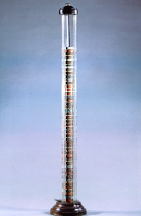
87.9 x 16.1 (diameter)
Zinc, copper, porcelain, glass and wood
CAT. 1824 : N.IV.166
Uma pilha galvanica da invenção de Aliseau.
A galvanic cell invented by Aliseau.
The history of electricity and magnetism inevitably embraces the work of Alessandro Volta. This was splendidly illustrated by a letter sent to Sir Goseff Banks, President of the Royal Society, dated March 20, 1800. In this letter, published in the Philosophical Transactions, Volta described his electric pile. The discovery was crucial to scientific and technological development in the 19th century.
As Volta said in his article, the apparatus he built was similar in its effects to those produced by the Leyden jar. However, his model "could be recharged by itself after each explosion". His apparatus seemed to have an inexhaustible charge and could act on an electric fluid continuously, and apparently incessantly.
In his report, Volta described the sensations he felt when he touched the pile terminals simultaneously, with moist fingers.
In some of the experiments he conducted, he plunged his hands into two containers of saline solution which were connected to the pile's terminals by means of a copper strip; this made the electric shock more intense.
Volta built different piles using thirty, forty or sixty elements. This enabled him to study the action of the pile on the electric fluid, depending on the number of elements, and he confirmed that the electric shock increased in intensity with the number of elements used in the pile. If more than twenty elements were used, it became painful.
The first piles constructed by Volta comprised alternating zinc and copper discs. Each was separated from its neighbour by a piece of cloth or card dampened by an acid solution. The column was supported by three vertical glass rods. The pile displayed here is one of Volta's earlier examples.